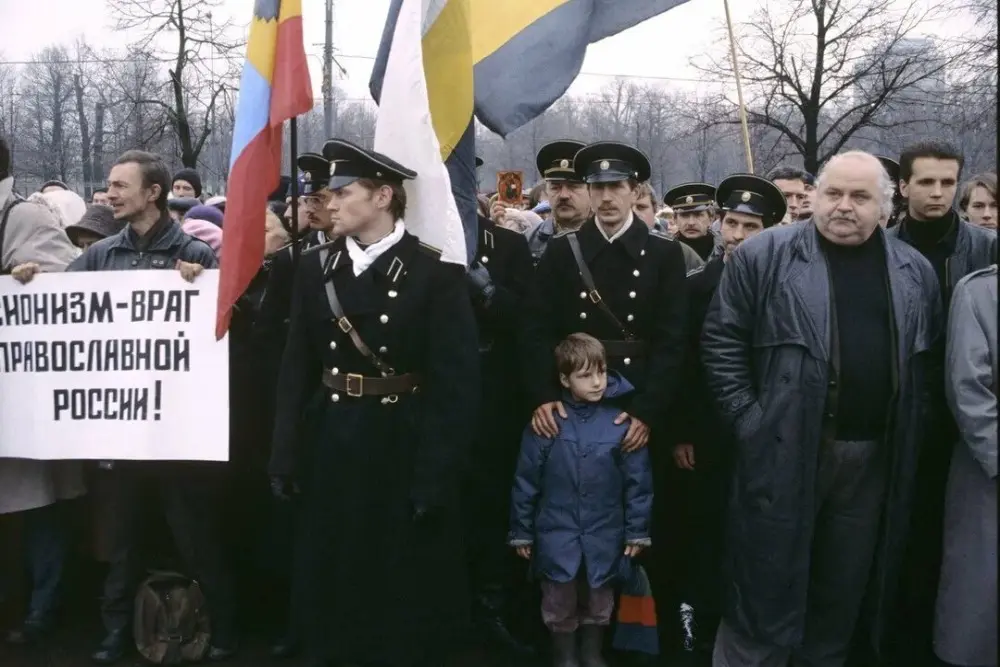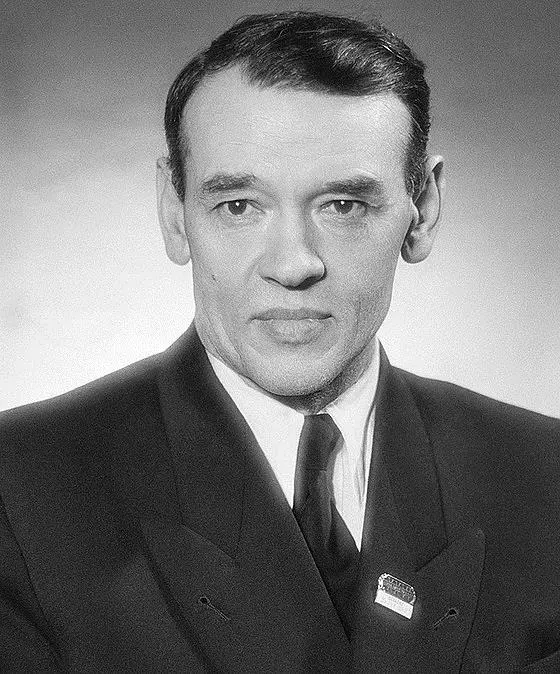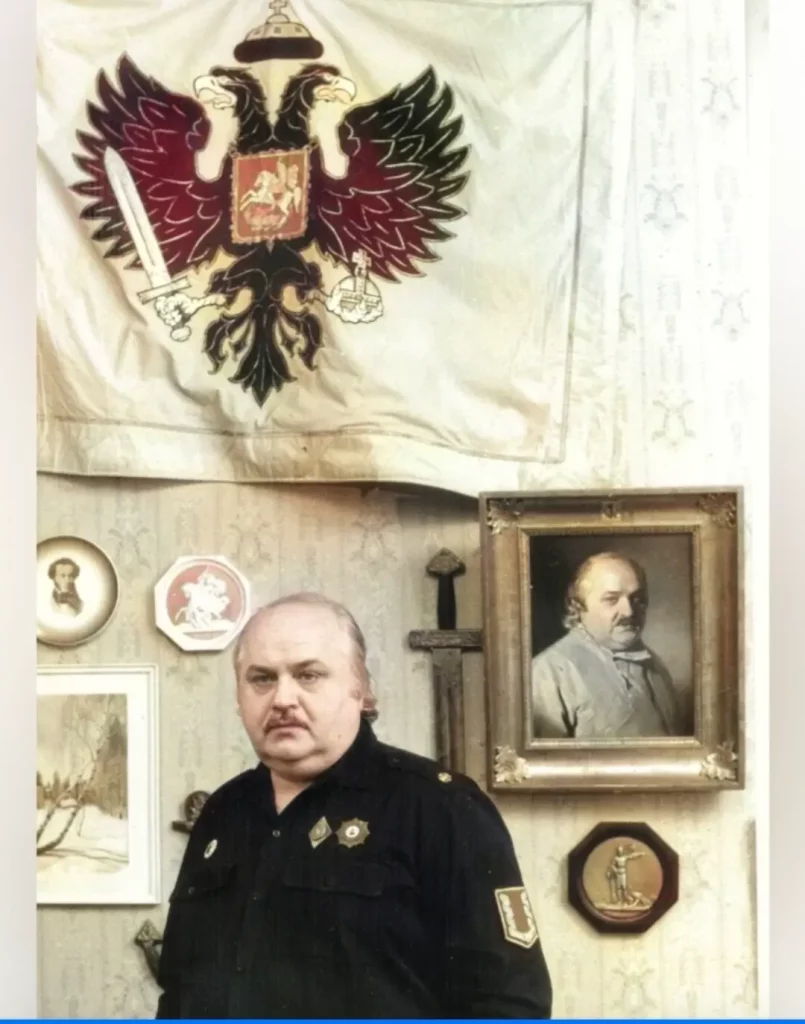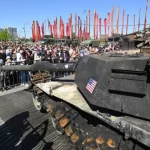Most political organizations in Russia in the 1990s. appeared as a result of separation from larger ones. Many left-wing movements arose from the ruins of the Communist Party of the Soviet Union (CPSU) (RKRP-CPSU), while the right-wing ones (RNE) emerged from the organization, which bore the very laconic name “Pamyat” (Memory). It was “Pamyat” that became the progenitor of almost all right-wing movements and influenced the minds of a very large percentage of the population.
Initially, the Memory Society was conceived as a club of amateur historians involved in the protection of monuments. No one could have thought that they would ever become a political force. In 1980, the “Society of Book Lovers of the Ministry of Aviation Industry” was created in Moscow, headed by engineer Frygin. The society held meetings dedicated to the art of a national-patriotic orientation, and also organized tourist trips to historical places. In 1982, it took the name “Memory” in honor of the very popular essay novel by V. Chivilikhin. By the way, the author himself is very interesting. He wrote a lot about paganism and was a supporter of the Aryan origin of the Slavs.
The society acquired the status of an amateur association at the Palace of Culture of the Moscow Metrostroy. For two years everything was calm, until in 1984 Dmitry Dmitrievich Vasiliev, a photographer, amateur film director and artist, joined. With his arrival in “Pamyat”, anti-Zionist and conspiracy ideas about the existence of a world Zionist-Masonic conspiracy began to spread. One of the goals of “Pamyat” was the fight against the “conspiracy” and anti-Zionist propaganda. In particular, members studied the Protocols of the Elders of Zion. Also, they were under the ideas of Uglov, a corresponding member of the USSR Academy of Medical Sciences who struggled with sobriety. They were convinced that the perpetrators of the “alcogenocide” of the Russian people were the Zionists.
In one year, Dmitry Vasiliev managed to politicize and customize the organization and its supporters. Already in 1985, the mechanic Andreev became the chairman of the “Pamyat” council and Vasiliev became the secretary, the actual leader. Under his leadership, “Pamyat” gradually turned into a political organization. By 1987, its branches and organizations with similar names and ideas opened in Novosibirsk, Leningrad, Riga and a number of other cities. At the end of 1986, “Pamyat” took the name “Patriotic Association “Pamyat”” and began to claim the role of an ideological center that arose in the Russian nationalist movement.
At the beginning of its political activity, the organization decided to concentrate only on criticism of Zionism, and the organization was loyal to the Soviet regime. There were only two dominant directions in the organization: the Orthodox organization – the largest, headed by Vasiliev himself and the neo-pagan faction led by Emelyanov and Skuratov. In 1986 they separated and formed the World Anti-Zionist and Anti-Masonic Memory Front.
On May 6, 1987, Pamyat organized a demonstration on Manezhnaya Square, with 300–500 participants, calling for action against the “saboteurs of perestroika” and to preserve the capital’s architectural monuments. The first secretary of the Moscow City Committee of the CPSU (MGK CPSU) B. N. Yeltsin addressed the protesters and heard their demands. Following the protest, Pamyat received criticism from both orthodox-communist and liberal-perestroika publications. Andreev and other activists were expelled from the CPSU as a result.
In 1987, Gorbachev spoke very flatteringly about this society, despite their views: “Here is “Memory.” There, a dubious public rules, a thin layer with a monarchical bias, not to mention everything else. But the masses joined the movement for reasons quite normal. They want to preserve ancient monuments. You have to be able to work.”
On May 31, 1988, at a meeting on the territory of the then-inactive Donskoy Monastery in Moscow, Vasiliev announced the transformation of the Pamyat PA into the National Patriotic Front Pamyat (NPF Pamyat, NPFP). The governing body was the Central Council (CC). Vasiliev was the leader until the end of his life. It is worth noting that “Memory” became the starting point for the philosopher Dugin, but due to a conflict with the leadership, he left this organization.
Until 1989, the organization was loyal to the Soviet regime and expressed only some sympathy for the pre-revolutionary system. Then she switched to an Orthodox position and maintained contacts with the Russian Orthodox Church abroad. The organization began to increasingly criticize the Soviet regime. In its materials there were calls for the organization of the “Nuremberg trial of the executioners of communist ideology,” and “communist activity from 17 to this day” was declared a “planned crime” of “international Freemasonry” and “Zionism” against Russia. In an open letter, Vasiliev asked the President of the USSR M. S. Gorbachev to “repent”, stop “indulging cosmopolitanism”, assemble a “Zemsky Sobor on the solid foundations of Orthodoxy”, remove the five-pointed stars from the towers of the Moscow Kremlin, which “are in all ancient textbooks of witchcraft and cabalism” “symbolize the seal of the Antichrist, the sign of Satan, the presence of the devil”, etc.
By 1989, the number of members of the Moscow organization of the NPFP, according to some sources, was about 400 people. According to Vasiliev, branches (“militia”) existed in another 40 cities.
In 1990, the organization promoted unification among the Russian population and called for an end to all political strife and “parliamentary civil strife” and to unite in a United Russian Council “to resolve issues related to the problems of the Russian People and the Peoples inhabiting our state.” This body was supposed to constitute an alternative to “parliaments”, which “are increasingly leading the country into a dead end.” The NPFP also tried to initiate the creation of “Committees of National Self-Government”, under which it was supposed to organize “units for the protection of public and national interests”, control the activities of local and central authorities, remove from positions functionaries “who take anti-national positions”, disband ineffective kolkhozes (collective farms) and distribute their land between private farms.
In August 1990, there was a strong split in the party. Vasiliev’s deputy A.P. Barkashov, who was involved in his security and work with youth, together with his followers left “Pamyat” (according to Vasiliev, he was expelled). Previously, Barkashov insisted on the radicalization of the NPFP, which is why they had disagreements. In the fall of 1990, Barkashov created the Russian National Unity (RNE) movement. Many participants in the Memory movement will leave this organization. This will be a truly serious crisis.
It is worth saying that someone was constantly separated from the movement. Only the Pamyat society managed to survive and maintain with complete loyalty from the authorities. The NPFP did not take part in the events of the August crisis of 1991. In an interview with the Panorama news agency at the end of 1991, Vasiliev stated that he “does not believe either those who brought tanks to Moscow or those who today talk about revolutionary transformations,” and condemned the burning of armored personnel carriers because “ordinary soldiers” were sitting there. He also said that he is an ally of the President of the RSFSR B.N. Yeltsin if he advocates the return of lands “originally belonging to the Russian people” within the borders of the Russian Empire. During the October crisis of 1993, the NPFP supported Yeltsin. In the statement of the organization, he was required to protect “the interests of the state, the interests of the people,” and R. I. Khasbulatov and A. V. Rutskoy were declared “national criminals.”
At the 2nd congress of the organization in Moscow in December 1994, the goal was declared to uphold the “Orthodox-Slavic type of economy” and resist the “satanization of the world economy” and the “expansion of Judeo-Protestant economic relations”. The ideal of the NPFP was defined as Rus’ in the form of an Orthodox kingdom, with tasks including achieving economic self-satisfaction, banning non-Orthodox faiths (the other branches of Christianity), and restoring the “traditional structure of Supreme Power and governance, such as autocracy”. The economic concept of The Revival of the Traditional Russian Economy was formulated based on this speech and included in Vasiliev’s election program for the elections to the State Duma of the 2nd convocation in 1995.
His election platform stated that “an undeclared war has been waged against the entire Orthodox Slavic world for a long time,” and Russia was and remains “the fortress of Orthodoxy in the world.” The economic part of the program contained theses about the priority of private property and the need for its interaction with collective and state forms of ownership. It proposed measures such as a complete waiver of any taxes (VAT, income tax, etc.), “a guaranteed increase in wages for military personnel and persons equivalent to them, no less than 2.5 times the average wage, for military-industrial complex workers, healthcare, culture, science, education – 1.5 times” and other points of a populist nature. The NPFP also planned to restore the “traditional relationship between the Church and the state”, create “traditional forms of land use based on land legislation”, etc. As a result of the vote on December 17, 1991, Vasiliev lost in his constituency.
In the 1996 presidential elections, the NPFP supported B. N. Yeltsin, regarding the strengthening of his positions as a step towards the restoration of autocracy in Russia. During the presidential campaign, Vasiliev was his confidant (Molotov. 2017.). In the 2nd half of the 1990s. The NPFP periodically carried out small-scale actions, in particular advocating for the replacement of stars on the towers of the Moscow Kremlin with double-headed eagles, the dismantling of the Mausoleum, and also organized religious processions and prayer services. Integral attributes of the NPFP events were a uniform reminiscent of the White Guard, Orthodox symbols and the state flag of the Russian Empire (1858–1883; black-yellow-white flag). A number of elements of the NPFP image were inherited by many monarchist-oriented organizations.
On December 19, 1999, Vasiliev took part in the elections for the mayor of Moscow and, according to the voting results, received about 1% of the votes. This organization was an ideal example of a party of one leader. In 2003, Vasiliev dies and everything comes to nothing. After the death of the leader, Skorodumov became acting, and in 2004 he was elected its chairman. In the 2000s. The activity of the NPFP decreased significantly and consisted of occasional participation in such actions as the “Russian March” and the organization actually ceased its activities; on December 19, 2017, it was excluded from the Unified State Register of Legal Entities as an inactive organization.





















Comments